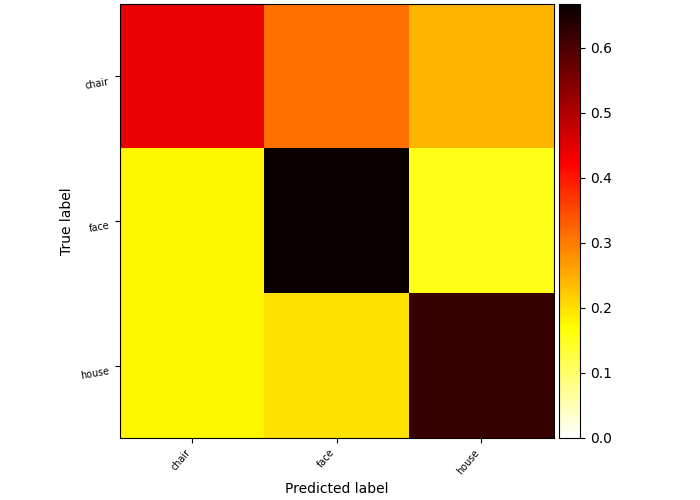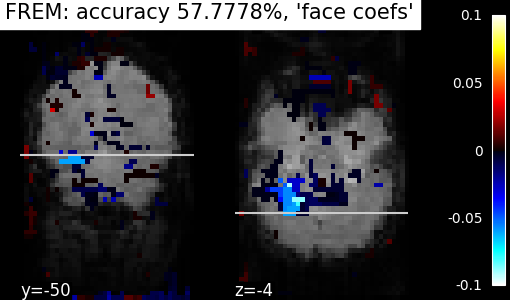Note
Go to the end to download the full example code or to run this example in your browser via Binder.
Decoding with FREM: face vs house vs chair object recognition¶
This example uses fast ensembling of regularized models (FREM) to decode a face vs house vs chair discrimination task from Haxby et al.[1] study. FREM uses an implicit spatial regularization through fast clustering and aggregates a high number of estimators trained on various splits of the training set, thus returning a very robust decoder at a lower computational cost than other spatially regularized methods.
To have more details, see: FREM: fast ensembling of regularized models for robust decoding.
Load the Haxby dataset¶
from nilearn.datasets import fetch_haxby
data_files = fetch_haxby()
[fetch_haxby] Dataset found in /home/remi-gau/nilearn_data/haxby2001
Load behavioral data
import pandas as pd
behavioral = pd.read_csv(data_files.session_target[0], sep=" ")
Restrict to face, house, and chair conditions
conditions = behavioral["labels"]
condition_mask = conditions.isin(["face", "house", "chair"])
Split data into train and test samples, using the chunks
condition_mask_train = (condition_mask) & (behavioral["chunks"] <= 6)
condition_mask_test = (condition_mask) & (behavioral["chunks"] > 6)
Apply this sample mask to X (fMRI data) and y (behavioral labels) Because the data is in one single large 4D image, we need to use index_img to do the split easily
from nilearn.image import index_img
func_filenames = data_files.func[0]
X_train = index_img(func_filenames, condition_mask_train)
X_test = index_img(func_filenames, condition_mask_test)
y_train = conditions[condition_mask_train].to_numpy()
y_test = conditions[condition_mask_test].to_numpy()
Compute the mean EPI to be used for the background of the plotting
from nilearn.image import mean_img
background_img = mean_img(func_filenames)
Fit FREM¶
from nilearn.decoding import FREMClassifier
Restrict analysis to within the brain mask
mask = data_files.mask
decoder = FREMClassifier(
mask=mask, cv=10, standardize="zscore_sample", n_jobs=2, verbose=1
)
Fit model on train data and predict on test data
decoder.fit(X_train, y_train)
y_pred = decoder.predict(X_test)
accuracy = (y_pred == y_test).mean() * 100.0
print(f"FREM classification accuracy : {accuracy:g}%")
[FREMClassifier.fit] Loading data from <nibabel.nifti1.Nifti1Image object at 0x7587912e8460>
[FREMClassifier.fit] Loading mask from '/home/remi-gau/nilearn_data/haxby2001/mask.nii.gz'
/home/remi-gau/github/nilearn/nilearn/examples/02_decoding/plot_haxby_frem.py:74: UserWarning: [NiftiMasker.fit] Generation of a mask has been requested (imgs != None) while a mask was given at masker creation. Given mask will be used.
decoder.fit(X_train, y_train)
[FREMClassifier.fit] Resampling mask
[FREMClassifier.fit] Finished fit
[FREMClassifier.fit] Loading data from <nibabel.nifti1.Nifti1Image object at 0x7587912e8460>
[FREMClassifier.fit] Extracting region signals
[FREMClassifier.fit] Cleaning extracted signals
[FREMClassifier.fit] Mask volume = 1.96442e+06mm^3 = 1964.42cm^3
[FREMClassifier.fit] Standard brain volume = 1.88299e+06mm^3
[FREMClassifier.fit] Original screening-percentile: 20
[FREMClassifier.fit] Corrected screening-percentile: 19.171
[Parallel(n_jobs=2)]: Using backend LokyBackend with 2 concurrent workers.
[Parallel(n_jobs=2)]: Done 30 out of 30 | elapsed: 13.0s finished
[FREMClassifier.fit] Computing image from signals
[FREMClassifier.fit] Computing image from signals
[FREMClassifier.fit] Computing image from signals
[FREMClassifier.fit] Computing image from signals
[FREMClassifier.fit] Computing image from signals
[FREMClassifier.fit] Computing image from signals
[FREMClassifier.predict] Loading data from <nibabel.nifti1.Nifti1Image object at 0x7587912ea500>
[FREMClassifier.predict] Extracting region signals
[FREMClassifier.predict] Cleaning extracted signals
FREM classification accuracy : 58.5185%
Plot confusion matrix¶
import numpy as np
from sklearn.metrics import confusion_matrix
from nilearn.plotting import plot_matrix, plot_stat_map, show
Calculate the confusion matrix
matrix = confusion_matrix(
y_test,
y_pred,
normalize="true",
)
Plot the confusion matrix
im = plot_matrix(
matrix,
labels=sorted(np.unique(y_test)),
vmin=0,
cmap="inferno",
)
# Add x/y-axis labels
ax = im.axes
ax.set_ylabel("True label")
ax.set_xlabel("Predicted label")
show()

Visualization of FREM weights¶
plot_stat_map(
decoder.coef_img_["face"],
background_img,
title=f"FREM: accuracy {accuracy:g}%, 'face coefs'",
cut_coords=(-50, -4),
display_mode="yz",
)
show()

FREM ensembling procedure yields an important improvement of decoding accuracy on this simple example compared to fitting only one model per fold and the clustering mechanism keeps its computational cost reasonable even on heavier examples. Here we ensembled several instances of l2-SVC, but FREMClassifier also works with ridge or logistic. FREMRegressor object is also available to solve regression problems.
References¶
Total running time of the script: (0 minutes 25.784 seconds)
Estimated memory usage: 1000 MB